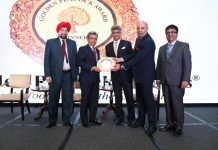
What is more promising is the sector’s transformation from low value processing in an unorganized segment to delivering high value, technology oriented, branded packaged products in a fast emerging organized segment. As a result of this transformation, we are witnessing a boom in packaged food segment with new product launches, introduction of new product categories and entry of new domestic and international players.
Frozen food is one such category which has caught the attention of both processors and consumers alike. Unlike shelf stable products, distribution of frozen products requires massive cold chain infrastructure which is limiting its market penetration. However, freezing ensures that these products are minimally processed with better retention of nutritive value and hence has a potential to become an alternative to home cooked or restaurant food.
The market for Frozen foods in India has grown at double digit growth rate in last few years reaching a size of about INR 19 Billion in 2012. Although the growth number looks impressive, it does not truly reflect the future growth potential of the industry. More than 45% of the current market is composed of export of minimally processed low value marine products, meat products, fruits and vegetables. Domestic per-capita consumption of frozen food is close to negligible and is about 50 times less than our counterparts in China. Though, the retail market for frozen food products, compared to its size in 2008 has doubled to INR 3650 million in 2012, it is still primarily driven by minimally processed vegetables. The market share of high value products such as ready meals in the consumption basket has remained constant during the last five years. Also, comparing the growth rate for different categories of packaged food reveals that frozen food has lagged behind many other high base volume categories such as snack food, ice creams, and breakfast cereals.
A deeper analysis of the industry reveals that the market for frozen food has a potential to grow three times in next five years; however, there are certain constraints which are limiting its growth. The industry is characterized by low revenue to asset ratio owing to massive investment in high precision manufacturing and storage infrastructure required to serve retail and food service segment. Typical revenue to asset ratio in frozen food segment will be in range of 1-2.5 as compared to range of 2-5 in other comparable segments such as ice cream, confectionary, etc. This aspect coupled with low market penetration due to underdeveloped cold chain and food retail infrastructure, creates entry barriers for new entrants and also restricts the existing players to invest heavily in branding and R&D for product innovation. This is leading to low awareness and acceptability of frozen product among consumers.
A market survey conducted by Sathguru Management Consultants revealed that consumers neither find the taste and texture of frozen product at par with fresh food, nor is the packaging appealing enough to prompt them to buy the product. The major deterrents in consuming frozen food are the consumer’s perception that it is unhealthy, due to the presence of chemical preservatives and having less nutritive value. Hence, consumers prefer to use frozen food only when fresh food is not available and do not see it as a substitute to home cooked or restaurant food. Moreover, the product range available in the country (in India) consists of minimally processed products in contrast to specialty products such as desserts, pizza, cookies, etc available in frozen forms in developed countries. Consumers consume processed food to get sensory experience which is difficult to get in home cooked food. Hence, in food service industry cuisines such as Chinese, Mexican and Italian are getting increasingly popular. However, frozen variants of these products are not available to Indian consumers.
It is however anticipated that recent changes in technology, macroeconomic environment and food consumption habits will catalyze Industry’s growth progression. The following trends will drive the transformation of the Industry:
- Technological changes will improve product acceptability. Public initiatives like incubation centers and venture funds for food processing sector will improve the R&D ecosystem. Growing interest of private equity investor in the sector will provide the necessary risk capital for product and packaging innovations. Technologies such as Ultrasound Assisted Freezing and High Pressure Shift Freezing will emerge to make frozen products similar to the fresh ones in terms of taste and texture.
- Growth in frozen food industry is highly correlated to growth in organized food retail and food service industry, both of which are poised to grow at CAGR of 20% for next 5 years. Entry and expansion of international retail chains like Auchan, Carrefour and Tesco will create a distribution platform for frozen food companies for deeper market penetration. Similarly QSR segment will witness robust growth in number of players and stores. These players will rely heavily on supply of products in semi processed frozen form which are consistent in terms of taste and offers a fresh value to consumers.
- Consumer preference will undergo remarkable change in next five years. Growing awareness about food safety and hygiene coupled with busy life style will prompt them to look at frozen food as a safe and convenient alternative of home cooked and street food.
- Macroeconomic changes will also favor consumption of frozen food. Rising labor cost is driving fine dining and reputed hotel chains to look at frozen raw materials as a means of saving time and cost. Rapid urbanization and increasing penetration of refrigerator and microwave will broaden the target segment for frozen food. Increase in disposable income and growing number of working couples will increase the frequency of eating out and consumption of convenient ready to eat food.
As per the analysis carried out by Sathguru Management Consultants, the retail market for frozen food has a potential to grow at CAGR of 20.5 per cent for next five years from INR 3,650 million in 2012 to 9300 million in 2017. Frozen food market for food service segment promises an even better opportunity. Estimated to be INR 6,350 million in 2012, it will expand at a CAGR of 26.6 per cent to reach INR 20,600 million by 2017. Industry players with product innovation and delivery competency and willingness to invest in branding will benefit the most from this growth and will capture an envious share in growing frozen food market in the country. To view the complete report, log on to www.sathguru.com. BWI































